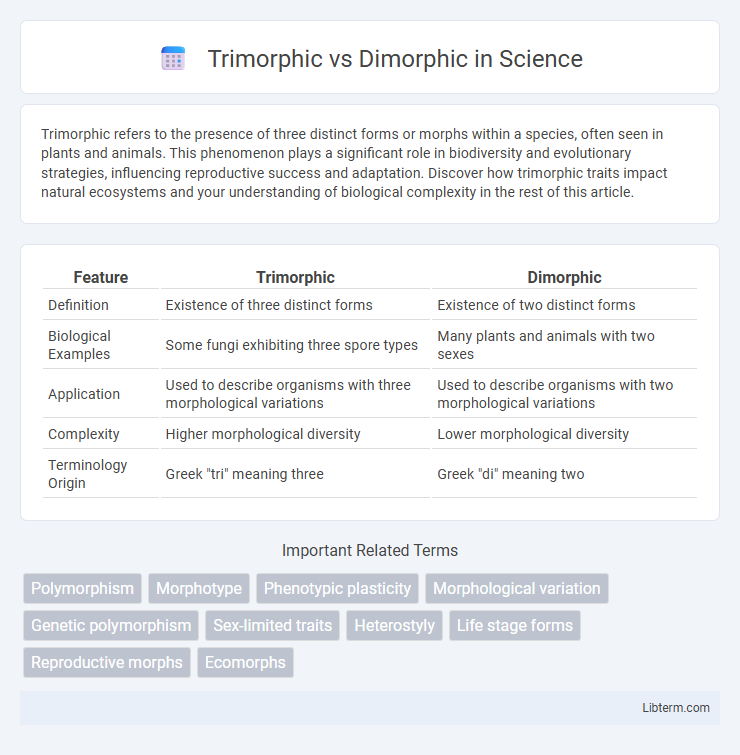Trimorphic refers to the presence of three distinct forms or morphs within a species, often seen in plants and animals. This phenomenon plays a significant role in biodiversity and evolutionary strategies, influencing reproductive success and adaptation. Discover how trimorphic traits impact natural ecosystems and your understanding of biological complexity in the rest of this article.
Table of Comparison
| Feature | Trimorphic | Dimorphic |
|---|---|---|
| Definition | Existence of three distinct forms | Existence of two distinct forms |
| Biological Examples | Some fungi exhibiting three spore types | Many plants and animals with two sexes |
| Application | Used to describe organisms with three morphological variations | Used to describe organisms with two morphological variations |
| Complexity | Higher morphological diversity | Lower morphological diversity |
| Terminology Origin | Greek "tri" meaning three | Greek "di" meaning two |
Introduction to Morphism: Trimorphic vs Dimorphic
Trimorphic organisms exhibit three distinct morphological forms within their species, enhancing adaptability and survival in diverse environments, whereas dimorphic species display only two distinct forms, typically related to reproductive roles or environmental adaptations. Morphism studies the structural variations that influence biological functions and evolutionary strategies, with trimorphism offering more complexity in traits compared to dimorphism. Understanding these patterns is crucial in fields like evolutionary biology, genetics, and ecology for analyzing species diversity and adaptation mechanisms.
Defining Trimorphism
Trimorphism refers to the occurrence of three distinct morphological forms within a species, often related to reproductive adaptations or roles, contrasting with dimorphism where only two forms exist. In trimorphic organisms, these three forms exhibit significant differences in structure, size, or function, enhancing survival and reproduction through diversified strategies. This biological phenomenon is observed in certain plants, insects, and marine species, providing a broader range of ecological niches compared to dimorphic counterparts.
Understanding Dimorphism
Dimorphism refers to the occurrence of two distinct forms or morphs within a species, often seen in physical traits like coloration, size, or shape, allowing specialized roles or adaptations. In contrast, trimorphic species display three unique morphs, which can increase genetic diversity and ecological interactions. Understanding dimorphism helps reveal evolutionary strategies in mating, survival, and resource allocation across various animal and plant species.
Key Differences Between Trimorphic and Dimorphic
Trimorphic organisms exhibit three distinct morphological forms or phases during their life cycle, while dimorphic organisms have only two. The key difference lies in the number of forms: trimorphism involves an additional morphological state, often seen in certain fungi and plants, enhancing adaptability and reproductive strategies. Dimorphism commonly appears in fungi, insects, and plants with two forms related to environmental or developmental conditions, impacting their ecological roles and survival mechanisms.
Examples of Trimorphism in Nature
Trimorphism in nature refers to the occurrence of three distinct forms within a species, often related to reproductive or morphological differences, unlike dimorphism which involves only two forms. Examples of trimorphism include the common primrose (Primula vulgaris), where flowers exhibit three different style lengths promoting cross-pollination, and the oyster species Crassostrea gigas, which can display three male morphs. This biological phenomenon enhances genetic diversity and reproductive success within species.
Examples of Dimorphism in Nature
Dimorphism commonly appears in nature through differences in size, color, or morphology between two distinct sexes or forms of the same species. Examples of dimorphism include the vibrant plumage of male peacocks contrasted with the more subdued feathers of females, and the size disparity in anglerfish where females are significantly larger than males. These adaptations often play crucial roles in mating strategies, survival, and reproductive success within various ecosystems.
Evolutionary Significance of Morphological Variations
Trimorphic species exhibit three distinct morphological forms within a population, contrasting with dimorphic species that have two, highlighting the evolutionary advantage of increased genetic and phenotypic diversity. This variation enhances survival and reproductive success by enabling adaptation to diverse environmental pressures and resource utilization strategies. Morphological polymorphism drives niche differentiation and reduces intraspecific competition, promoting balanced selection and long-term species stability.
Genetic and Environmental Factors Influencing Morphism
Trimorphic and dimorphic systems differ primarily in the number of distinct morphs present, with trimorphic species exhibiting three morphs and dimorphic species showing two. Genetic factors such as allelic variation and gene regulation play a crucial role in determining morph presence and frequency, often maintained through mechanisms like balancing selection. Environmental influences, including habitat variability and resource availability, interact with genetic predispositions to shape the expression and success of each morph within populations.
Applications and Importance in Science and Research
Trimorphic and dimorphic structures play critical roles in materials science and biology, influencing applications from pharmaceuticals to environmental studies. Trimorphic substances exhibit three distinct crystalline forms, enhancing drug solubility and stability, while dimorphic materials with two crystalline modifications allow tailored mechanical and thermal properties for industrial uses. Understanding polymorphs' structural variations aids in developing advanced materials, optimizing drug efficacy, and improving biomolecular research, underscoring their vital importance in scientific innovation and technology.
Conclusion: The Impact of Morphism on Biodiversity
Trimorphic species exhibit three distinct forms within a population, increasing genetic diversity more than dimorphic species, which only have two forms. This greater variety enhances adaptability to environmental changes, supporting ecosystem resilience and stability. Biodiversity benefits from trimorphism by fostering complex interactions and evolutionary potential that dimorphism alone may not sustain.
Trimorphic Infographic

 libterm.com
libterm.com